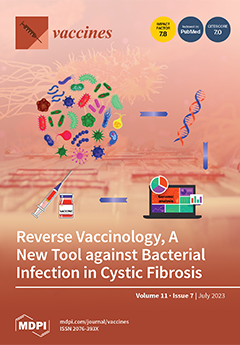The threat of bacterial septicemia caused by
Aeromonas hydrophila infection to aquaculture growth can be prevented through vaccination, but differences among
A. hydrophila strains may affect the effectiveness of non-conserved subunit vaccines or non-inactivated
A. hydrophila vaccines, making the identification and development of
[...] Read more.
The threat of bacterial septicemia caused by
Aeromonas hydrophila infection to aquaculture growth can be prevented through vaccination, but differences among
A. hydrophila strains may affect the effectiveness of non-conserved subunit vaccines or non-inactivated
A. hydrophila vaccines, making the identification and development of conserved antigens crucial. In this study, a bioinformatics analysis of 4268 protein sequences encoded by the
A. hydrophila J-1 strain whole genome was performed based on reverse vaccinology. The specific analysis included signal peptide prediction, transmembrane helical structure prediction, subcellular localization prediction, and antigenicity and adhesion evaluation, as well as interspecific and intraspecific homology comparison, thereby screening the 39 conserved proteins as candidate antigens for
A. hydrophila vaccine. The 9 isolated
A. hydrophila strains from diseased fish were categorized into 6 different molecular subtypes via enterobacterial repetitive intergenic consensus (ERIC)-PCR technology, and the coding regions of 39 identified candidate proteins were amplified via PCR and sequenced to verify their conservation in different subtypes of
A. hydrophila and other
Aeromonas species. In this way, conserved proteins were screened out according to the comparison results. Briefly, 16 proteins were highly conserved in different
A. hydrophila subtypes, of which 2 proteins were highly conserved in
Aeromonas species, which could be selected as candidate antigens for vaccines development, including type IV pilus secretin PilQ (AJE35401.1) and TolC family outer membrane protein (AJE35877.1). The present study screened the conserved antigens of
A. hydrophila by using reverse vaccinology, which provided basic foundations for developing broad-spectrum protective vaccines of
A. hydrophila.
Full article






